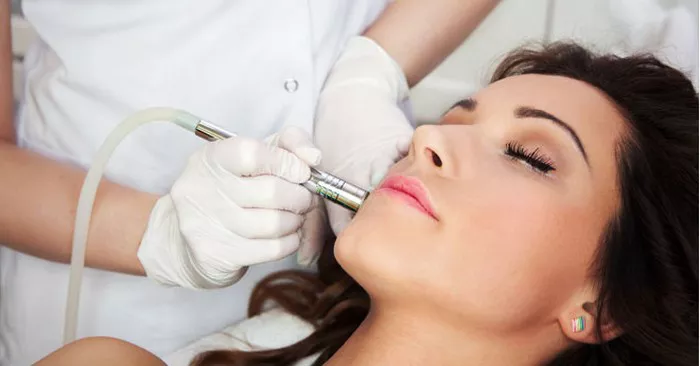Microdermabrasion and chemical peels are popular skincare treatments that can improve the appearance of the skin. They both work by exfoliating the outer layer of the skin, but they utilize different techniques. Microdermabrasion involves mechanically removing dead skin cells, while chemical peels use chemical solutions to dissolve the top layer of the skin. Many people wonder if it’s safe to combine these two treatments or if they should be done separately. In this article, we will explore whether you can do a chemical peel after microdermabrasion and what factors to consider.
Understanding Microdermabrasion and Chemical Peels
Microdermabrasion is a non-invasive procedure that uses a handheld device to exfoliate the outermost layer of the skin. It utilizes tiny crystals or a diamond-tipped wand to gently remove dead skin cells and stimulate cell turnover. This treatment can help reduce the appearance of fine lines, wrinkles, acne scars, and sun damage. Microdermabrasion is generally safe for all skin types and requires little to no downtime.
On the other hand, chemical peels are cosmetic treatments that involve the application of a chemical solution to the skin. The solution causes the top layer of the skin to peel off, revealing smoother and rejuvenated skin underneath. Chemical peels are available in different strengths, ranging from superficial to deep. They can address various skin concerns, including acne, hyperpigmentation, uneven texture, and signs of aging. However, the intensity of the peel and the downtime required depend on the type of peel used.
Combining Microdermabrasion and Chemical Peels: Is It Safe?
The question arises whether it is safe to combine microdermabrasion with a chemical peel in the same session. While both treatments serve the purpose of exfoliating the skin, it is generally not recommended to undergo them simultaneously. The reason behind this is the potential for skin irritation and sensitivity.
Microdermabrasion can leave the skin slightly inflamed and sensitive immediately after the treatment. The exfoliation process removes the protective barrier of dead skin cells, leaving the fresh layer more vulnerable to external irritants. Applying a chemical peel immediately after microdermabrasion can exacerbate this sensitivity and lead to adverse reactions such as redness, burning, and peeling. It’s essential to allow the skin to recover and regain its balance before subjecting it to further treatments.
Timing and Sequencing: What’s the Right Approach?
If you’re interested in both microdermabrasion and a chemical peel, it’s important to plan the timing and sequencing of the treatments properly. The general recommendation is to space them out and not perform them on the same day.
The ideal approach is to undergo microdermabrasion first and wait for a few weeks before scheduling a chemical peel. This time allows your skin to heal and regenerate, reducing the risk of adverse reactions. Microdermabrasion prepares the skin by removing the outer layer of dead skin cells, allowing the chemical peel to penetrate more effectively during the subsequent treatment.
It’s important to consult with a skincare professional or dermatologist who can assess your skin condition and provide personalized advice. They will be able to determine the appropriate timing between the treatments based on your skin’s needs and tolerance.
Considerations for Combining Microdermabrasion and Chemical Peels
While it is generally recommended to space out microdermabrasion and chemical peels, there are certain situations where combining the two treatments might be considered. However, this decision should always be made under the guidance of a skincare professional.
Combination Treatments
Some skincare clinics offer combination treatments that incorporate microdermabrasion and a light chemical peel in a single session. These treatments are specifically designed to work synergistically and provide enhanced results. However, they typically use gentle peels with lower concentrations to minimize the risk of adverse reactions.
Professional Assessment
Your skincare professional or dermatologist will evaluate your skin condition, sensitivity, and any ongoing treatments before deciding if combining microdermabrasion and a chemical peel is suitable for you. They will take into account factors such as your skin type, the intensity of the peel, and the desired outcome to ensure your safety and satisfaction.
Gradual Approach
If you decide to combine microdermabrasion and a chemical peel, it’s essential to start with a conservative approach. This means using lower concentrations and shorter exposure times for the chemical peel to minimize the risk of adverse effects. As your skin becomes accustomed to the combination, your skincare professional may adjust the treatment parameters accordingly.
Conclusion
While microdermabrasion and chemical peels are effective treatments for improving the skin’s appearance, it is generally recommended to space them out rather than performing them on the same day. Microdermabrasion should be done first, allowing the skin to recover before undergoing a chemical peel. The timing and sequencing of these treatments should be determined by a skincare professional based on your specific needs and skin condition. By following their guidance, you can achieve optimal results and minimize the risk of adverse reactions. Remember, taking care of your skin’s health and well-being should always be the top priority.

